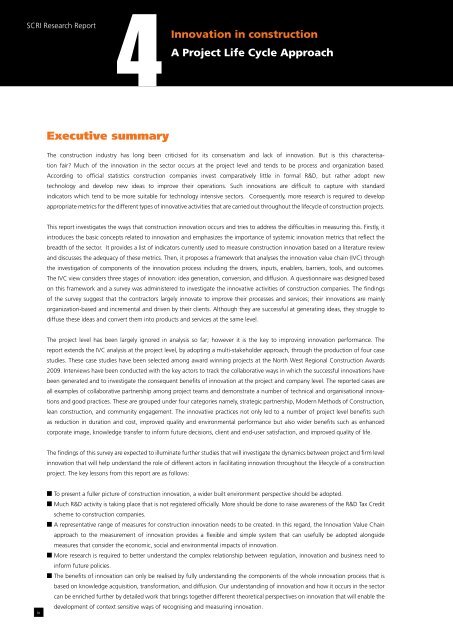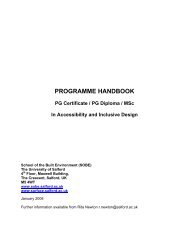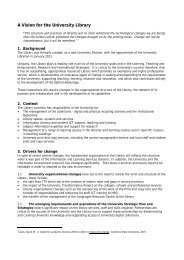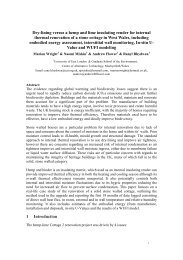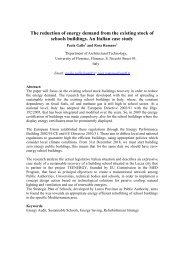Innovation in Construction A Project Life Cycle Approach
Innovation in Construction A Project Life Cycle Approach
Innovation in Construction A Project Life Cycle Approach
Create successful ePaper yourself
Turn your PDF publications into a flip-book with our unique Google optimized e-Paper software.
SCRI Research Report4<strong>Innovation</strong> <strong>in</strong> constructionA <strong>Project</strong> <strong>Life</strong> <strong>Cycle</strong> <strong>Approach</strong>Executive summaryThe construction <strong>in</strong>dustry has long been criticised for its conservatism and lack of <strong>in</strong>novation. But is this characterisationfair? Much of the <strong>in</strong>novation <strong>in</strong> the sector occurs at the project level and tends to be process and organization based.Accord<strong>in</strong>g to official statistics construction companies <strong>in</strong>vest comparatively little <strong>in</strong> formal R&D, but rather adopt newtechnology and develop new ideas to improve their operations. Such <strong>in</strong>novations are difficult to capture with standard<strong>in</strong>dicators which tend to be more suitable for technology <strong>in</strong>tensive sectors. Consequently, more research is required to developappropriate metrics for the different types of <strong>in</strong>novative activities that are carried out throughout the lifecycle of construction projects.This report <strong>in</strong>vestigates the ways that construction <strong>in</strong>novation occurs and tries to address the difficulties <strong>in</strong> measur<strong>in</strong>g this. Firstly, it<strong>in</strong>troduces the basic concepts related to <strong>in</strong>novation and emphasizes the importance of systemic <strong>in</strong>novation metrics that reflect thebreadth of the sector. It provides a list of <strong>in</strong>dicators currently used to measure construction <strong>in</strong>novation based on a literature reviewand discusses the adequacy of these metrics. Then, it proposes a framework that analyses the <strong>in</strong>novation value cha<strong>in</strong> (IVC) throughthe <strong>in</strong>vestigation of components of the <strong>in</strong>novation process <strong>in</strong>clud<strong>in</strong>g the drivers, <strong>in</strong>puts, enablers, barriers, tools, and outcomes.The IVC view considers three stages of <strong>in</strong>novation: idea generation, conversion, and diffusion. A questionnaire was designed basedon this framework and a survey was adm<strong>in</strong>istered to <strong>in</strong>vestigate the <strong>in</strong>novative activities of construction companies. The f<strong>in</strong>d<strong>in</strong>gsof the survey suggest that the contractors largely <strong>in</strong>novate to improve their processes and services; their <strong>in</strong>novations are ma<strong>in</strong>lyorganization-based and <strong>in</strong>cremental and driven by their clients. Although they are successful at generat<strong>in</strong>g ideas, they struggle todiffuse these ideas and convert them <strong>in</strong>to products and services at the same level.The project level has been largely ignored <strong>in</strong> analysis so far; however it is the key to improv<strong>in</strong>g <strong>in</strong>novation performance. Thereport extends the IVC analysis at the project level, by adopt<strong>in</strong>g a multi-stakeholder approach, through the production of four casestudies. These case studies have been selected among award w<strong>in</strong>n<strong>in</strong>g projects at the North West Regional <strong>Construction</strong> Awards2009. Interviews have been conducted with the key actors to track the collaborative ways <strong>in</strong> which the successful <strong>in</strong>novations havebeen generated and to <strong>in</strong>vestigate the consequent benefits of <strong>in</strong>novation at the project and company level. The reported cases areall examples of collaborative partnership among project teams and demonstrate a number of technical and organisational <strong>in</strong>novationsand good practices. These are grouped under four categories namely, strategic partnership, Modern Methods of <strong>Construction</strong>,lean construction, and community engagement. The <strong>in</strong>novative practices not only led to a number of project level benefits suchas reduction <strong>in</strong> duration and cost, improved quality and environmental performance but also wider benefits such as enhancedcorporate image, knowledge transfer to <strong>in</strong>form future decisions, client and end-user satisfaction, and improved quality of life.The f<strong>in</strong>d<strong>in</strong>gs of this survey are expected to illum<strong>in</strong>ate further studies that will <strong>in</strong>vestigate the dynamics between project and firm level<strong>in</strong>novation that will help understand the role of different actors <strong>in</strong> facilitat<strong>in</strong>g <strong>in</strong>novation throughout the lifecycle of a constructionproject. The key lessons from this report are as follows:ivn To present a fuller picture of construction <strong>in</strong>novation, a wider built environment perspective should be adopted.n Much R&D activity is tak<strong>in</strong>g place that is not registered officially. More should be done to raise awareness of the R&D Tax Creditscheme to construction companies.n A representative range of measures for construction <strong>in</strong>novation needs to be created. In this regard, the <strong>Innovation</strong> Value Cha<strong>in</strong>approach to the measurement of <strong>in</strong>novation provides a flexible and simple system that can usefully be adopted alongsidemeasures that consider the economic, social and environmental impacts of <strong>in</strong>novation.n More research is required to better understand the complex relationship between regulation, <strong>in</strong>novation and bus<strong>in</strong>ess need to<strong>in</strong>form future policies.n The benefits of <strong>in</strong>novation can only be realised by fully understand<strong>in</strong>g the components of the whole <strong>in</strong>novation process that isbased on knowledge acquisition, transformation, and diffusion. Our understand<strong>in</strong>g of <strong>in</strong>novation and how it occurs <strong>in</strong> the sectorcan be enriched further by detailed work that br<strong>in</strong>gs together different theoretical perspectives on <strong>in</strong>novation that will enable thedevelopment of context sensitive ways of recognis<strong>in</strong>g and measur<strong>in</strong>g <strong>in</strong>novation.


